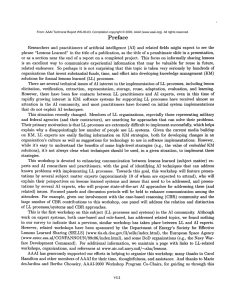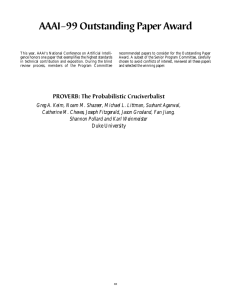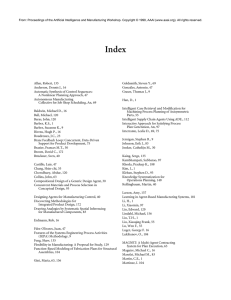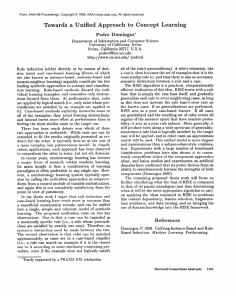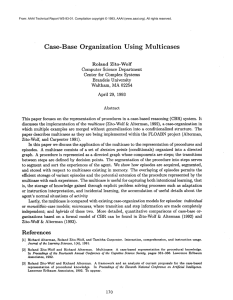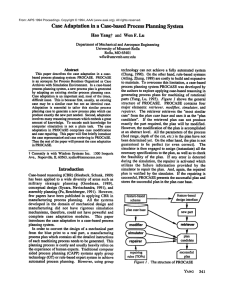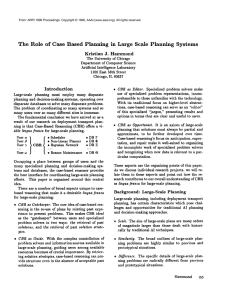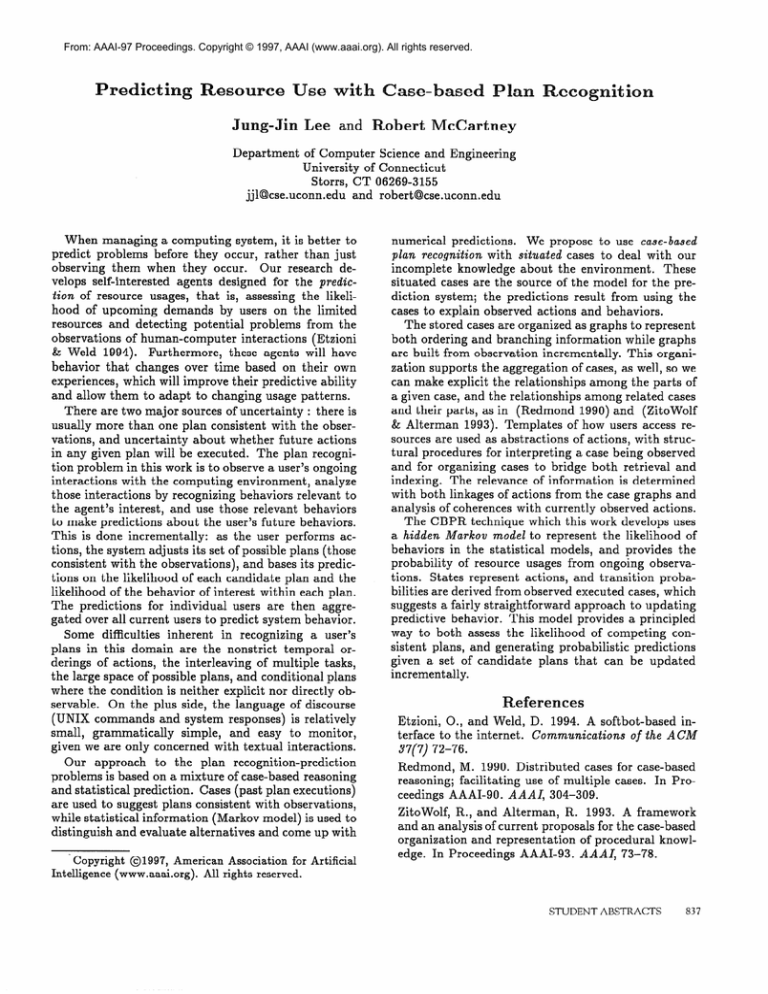
From: AAAI-97 Proceedings. Copyright © 1997, AAAI (www.aaai.org). All rights reserved.
Predicting
Resource
Jung-Jin
Use with CaseLee and Robert
ecognit io
McCartney
Department
of Computer Science and Engineering
University of Connecticut
Storrs, CT 06269-3155
jjlQcse.uconn.edu
and robert@cse.uconn.edu
When managing a computing system, it is better to
predict problems before they occur, rather than just
observing them when they occur.
Our research develops self-interested
agents designed for the prediction of resource usages, that is, assessing the likelihood of upcoming demands by users on the limited
resources and detecting
potential problems from the
observations
of human-computer
interactions
(Etzioni
& Weld 1994).
Furthermore,
these agents will have
behavior that changes over time based on their own
experiences,
which will improve their predictive ability
and allow them to adapt to changing usage patterns.
There are two major sources of uncertainty
: there is
usually more than one plan consistent with the observations, and uncertainty
about whether future actions
in any given plan will be executed.
The plan recognition problem in this work is to observe a user’s ongoing
interactions
with the computing environment,
analyze
those interactions
by recognizing behaviors relevant to
the agent’s interest, and use those relevant behaviors
to make predictions about the user’s future behaviors.
This is done incrementally:
as the user performs actions, the system adjusts its set of possible plans (those
consistent with the observations),
and bases its predictions on the likelihood of each candidate plan and the
likelihood of the behavior of interest within each plan.
The predictions
for individual users are then aggregated over all current users to predict system behavior.
Some difficulties
inherent
in recognizing
a user’s
plans in this domain are the nonstrict
temporal orderings of actions, the interleaving
of multiple tasks,
the large space of possible plans, and conditional plans
where the condition is neither explicit nor directly observable.
On the plus side, the language of discourse
(UNIX commands and system responses) is relatively
small, grammatically
simple, and easy to monitor,
given we are only concerned with textual interactions.
Our approach
to the plan recognition-prediction
problems is based on a mixture of case-based reasoning
and statistical prediction.
Cases (past plan executions)
are used to suggest plans consistent with observations,
while statistical information
(Markov model) is used to
distinguish and evaluate alternatives and come up with
Copyright 01997,
American Association for Artificial
Intelligence (www.aaai.org). All rights reserved.
numerical predictions.
We propose to use case-based
plan recognition with situated cases to deal with our
incomplete knowledge about the environment.
These
situated cases are the source of the model for the prediction system; the predictions
result from using the
cases to explain observed actions and behaviors.
The stored cases are organized as graphs to represent
both ordering and branching information while graphs
are built from observation incrementally.
This organization supports the aggregation of cases, as well, so we
can make explicit the relationships
among the parts of
a given case, and the relationships
among related cases
and their parts, as in (Redmond 1990) and (ZitoWolf
& Alterman 1993). Templates of how users access resources are used as abstractions
of actions, with structural procedures for interpreting
a case being observed
and for organizing cases to bridge both retrieval and
indexing.
The relevance of information
is determined
with both linkages of actions from the case graphs and
analysis of coherences with currently observed actions.
The CBPR technique which this work develops uses
a hidden Markov modd to represent the likelihood of
behaviors in the statistical
models, and provides the
probability
of resource usages from ongoing observations. States represent actions, and transition
probabilities are derived from observed executed cases, which
suggests a fairly straightforward
approach to updating
predictive behavior. This model provides a principled
way to both assess the likelihood of competing
consistent plans, and generating probabilistic
predictions
given a set of candidate
plans that can be updated
incrementally.
eferences
Etzioni, O., and Weld,
terface to the internet.
37(7) 72-76.
D. 1994. A softbot-based
inCommunications
of the ACM
Redmond, M. 1990. Distributed
cases for case-based
reasoning; facilitating
use of multiple cases. In Proceedings AAAI-90. AAAI, 304-309.
ZitoWolf, R., and Alterman,
R. 1993. A framework
and an analysis of current proposals for the case-based
organization and representation
of procedural knowledge. In Proceedings AAAI-93.
AAAI, 73-78.
STUDENT ABSTRACTS
837




